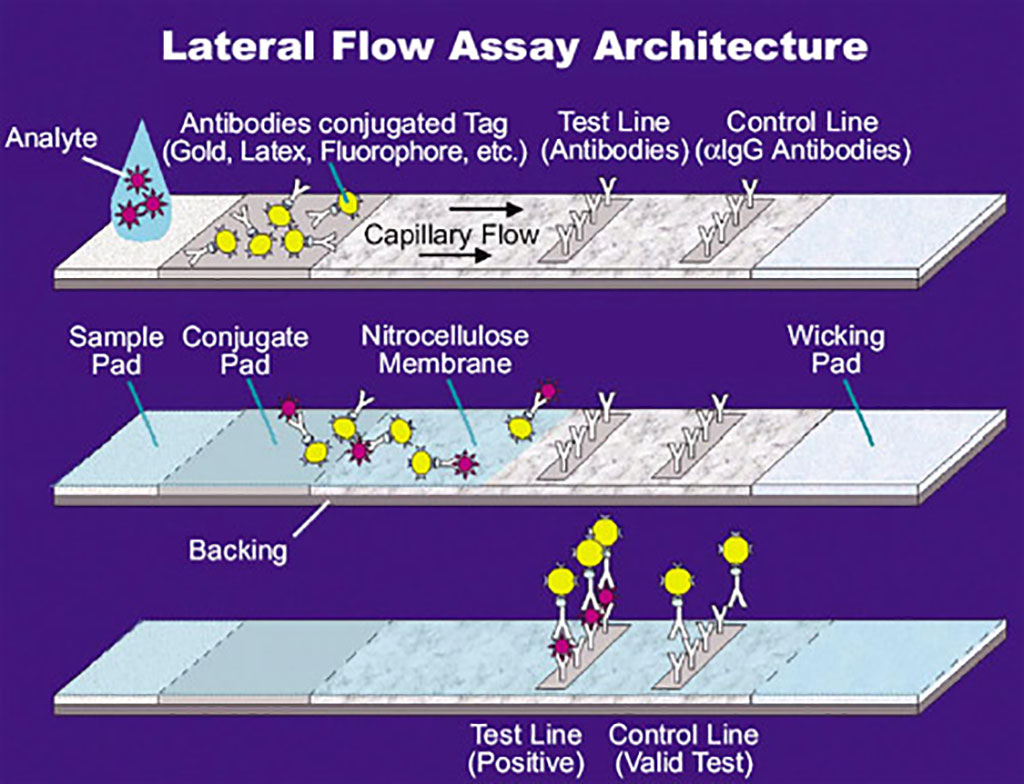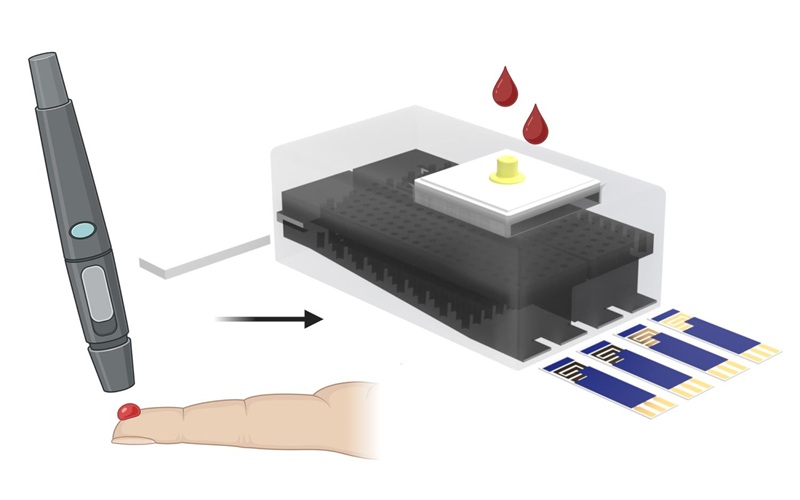Rapid Lateral Flow Assays Detect COVID-19 Variants and Differentiate COVID-19 from Other Respiratory Viral Diseases
|
By LabMedica International staff writers Posted on 02 Mar 2021 |

Image: Illustration of a lateral flow assay (LFA) (Photo courtesy of U.S. National Aeronautics and Space Administration via Wikimedia Commons)
A recent publication reported the development of two rapid diagnostic tests - one that detects COVID-19 variants and one that differentiates COVID-19 from other respiratory viral diseases.
Investigators at the University of Minnesota Medical School (Minneapolis/St.Paul, USA) used the CRISPR/Cas9 gene editing tool to develop two rapid lateral flow diagnostic tests. CRISPRs (clustered regularly interspaced short palindromic repeats) are segments of prokaryotic DNA containing short repetitions of base sequences. Each repetition is followed by short segments of "spacer DNA" from previous exposures to a bacterial virus or plasmid. Since 2013, the CRISPR/Cas9 system has been used in research for gene editing (adding, disrupting, or changing the sequence of specific genes) and gene regulation. By delivering the Cas9 enzyme and appropriate guide RNAs (sgRNAs) into a cell, the organism's genome can be cut at any desired location. The conventional CRISPR/Cas9 system from Streptococcus pyogenes is composed of two parts: the Cas9 enzyme, which cleaves the DNA molecule and specific RNA guides that shepherd the Cas9 protein to the target gene on a DNA strand.
The investigators integrated commercially available reagents into a CRISPR/Cas9-based lateral flow assay (LFA) that could detect severe acute respiratory syndrome coronavirus 2 (SARS-CoV-2) sequences with single-base specificity. This approach required minimal equipment and represented a simplified platform for field-based deployment. They also developed a rapid, multiplex fluorescence CRISPR/Cas9 nuclease cleavage assay capable of detecting and differentiating SARS-CoV-2, influenza A and B, and respiratory syncytial virus (RSV) in a single reaction.
The LFA test strips employed bound fluorescein isothiocyanate (FITC)/6-Carboxyfluorescein (FAM) and biotin to generate a positive result. Therefore, the investigators used a FITC/FAM-labeled PCR primer and a nuclease inactive (“dead”) biotinylated Cas9 and a single sgRNA specific for the ORF8a gene of SARS-Co-V-2 to label amplicons for detection by LFA. This approach was capable of single-nucleotide resolution and avoided false positives from primer dimer or non-specific amplification artifacts that could occur with the use of tandem FITC- and biotin-labeled primers for LFA.
"The approval of the SARS-CoV-2 vaccine is highly promising, but the time between first doses and population immunity may be months," said first author Dr. Mark J. Osborn, assistant professor of pediatrics at the University of Minnesota Medical School. "This testing platform can help bridge the gap between immunization and immunity."
The rapid LFA tests were described in the February 12, 2021, online edition of the journal Bioengineering.
Related Links:
University of Minnesota Medical School
Investigators at the University of Minnesota Medical School (Minneapolis/St.Paul, USA) used the CRISPR/Cas9 gene editing tool to develop two rapid lateral flow diagnostic tests. CRISPRs (clustered regularly interspaced short palindromic repeats) are segments of prokaryotic DNA containing short repetitions of base sequences. Each repetition is followed by short segments of "spacer DNA" from previous exposures to a bacterial virus or plasmid. Since 2013, the CRISPR/Cas9 system has been used in research for gene editing (adding, disrupting, or changing the sequence of specific genes) and gene regulation. By delivering the Cas9 enzyme and appropriate guide RNAs (sgRNAs) into a cell, the organism's genome can be cut at any desired location. The conventional CRISPR/Cas9 system from Streptococcus pyogenes is composed of two parts: the Cas9 enzyme, which cleaves the DNA molecule and specific RNA guides that shepherd the Cas9 protein to the target gene on a DNA strand.
The investigators integrated commercially available reagents into a CRISPR/Cas9-based lateral flow assay (LFA) that could detect severe acute respiratory syndrome coronavirus 2 (SARS-CoV-2) sequences with single-base specificity. This approach required minimal equipment and represented a simplified platform for field-based deployment. They also developed a rapid, multiplex fluorescence CRISPR/Cas9 nuclease cleavage assay capable of detecting and differentiating SARS-CoV-2, influenza A and B, and respiratory syncytial virus (RSV) in a single reaction.
The LFA test strips employed bound fluorescein isothiocyanate (FITC)/6-Carboxyfluorescein (FAM) and biotin to generate a positive result. Therefore, the investigators used a FITC/FAM-labeled PCR primer and a nuclease inactive (“dead”) biotinylated Cas9 and a single sgRNA specific for the ORF8a gene of SARS-Co-V-2 to label amplicons for detection by LFA. This approach was capable of single-nucleotide resolution and avoided false positives from primer dimer or non-specific amplification artifacts that could occur with the use of tandem FITC- and biotin-labeled primers for LFA.
"The approval of the SARS-CoV-2 vaccine is highly promising, but the time between first doses and population immunity may be months," said first author Dr. Mark J. Osborn, assistant professor of pediatrics at the University of Minnesota Medical School. "This testing platform can help bridge the gap between immunization and immunity."
The rapid LFA tests were described in the February 12, 2021, online edition of the journal Bioengineering.
Related Links:
University of Minnesota Medical School
Latest Molecular Diagnostics News
- Genetic Marker to Help Children with T-Cell Leukemia Avoid Unnecessary Chemotherapy
- Four-Gene Blood Test Rules Out Bacterial Lung Infection
- New PCR Test Improves Diagnostic Accuracy of Bacterial Vaginosis and Candida Vaginitis
- New Serum Marker-Editing Strategy to Improve Diagnosis of Neurological Diseases
- World’s First Genetic Type 1 Diabetes Risk Test Enables Early Detection
- Blood Test to Help Low-Risk Gastric Cancer Patients Avoid Unnecessary Surgery
- First-Of-Its-Kind Automated System Speeds Myeloma Diagnosis
- Blood Protein Profiles Predict Mortality Risk for Earlier Medical Intervention
- First Of Its Kind Blood Test Detects Gastric Cancer in Asymptomatic Patients
- Portable Molecular Test Detects STIs at POC in 15 Minutes
- Benchtop Analyzer Runs Chemistries, Immunoassays and Hematology in Single Device
- POC Bordetella Test Delivers PCR-Accurate Results in 15 Minutes
- Pinprick Blood Test Could Detect Disease 10 Years Before Symptoms Appear
- Refined C-Reactive Protein Cutoffs Help Assess Sepsis Risk in Preterm Babies
- Blood Test Accurately Detects Brain Amyloid Pathology in Symptomatic Patients
- New Molecular Test Improves Diagnostic Accuracy of Lyme Disease
Channels
Clinical Chemistry
view channel
Chemical Imaging Probe Could Track and Treat Prostate Cancer
Prostate cancer remains a leading cause of illness and death among men, with many patients eventually developing resistance to standard hormone-blocking therapies. These drugs often lose effectiveness... Read more
Mismatch Between Two Common Kidney Function Tests Indicates Serious Health Problems
Creatinine has long been the standard for measuring kidney filtration, while cystatin C — a protein produced by all human cells — has been recommended as a complementary marker because it is influenced... Read moreHematology
view channel
Platelet Activity Blood Test in Middle Age Could Identify Early Alzheimer’s Risk
Early detection of Alzheimer’s disease remains one of the biggest unmet needs in neurology, particularly because the biological changes underlying the disorder begin decades before memory symptoms appear.... Read more
Microvesicles Measurement Could Detect Vascular Injury in Sickle Cell Disease Patients
Assessing disease severity in sickle cell disease (SCD) remains challenging, especially when trying to predict hemolysis, vascular injury, and risk of complications such as vaso-occlusive crises.... Read more
ADLM’s New Coagulation Testing Guidance to Improve Care for Patients on Blood Thinners
Direct oral anticoagulants (DOACs) are one of the most common types of blood thinners. Patients take them to prevent a host of complications that could arise from blood clotting, including stroke, deep... Read moreImmunology
view channel
New Test Distinguishes Vaccine-Induced False Positives from Active HIV Infection
Since HIV was identified in 1983, more than 91 million people have contracted the virus, and over 44 million have died from related causes. Today, nearly 40 million individuals worldwide live with HIV-1,... Read more
Gene Signature Test Predicts Response to Key Breast Cancer Treatment
DK4/6 inhibitors paired with hormone therapy have become a cornerstone treatment for advanced HR+/HER2– breast cancer, slowing tumor growth by blocking key proteins that drive cell division.... Read more
Chip Captures Cancer Cells from Blood to Help Select Right Breast Cancer Treatment
Ductal carcinoma in situ (DCIS) accounts for about a quarter of all breast cancer cases and generally carries a good prognosis. This non-invasive form of the disease may or may not become life-threatening.... Read moreMicrobiology
view channel
Rapid Diagnostic Test Matches Gold Standard for Sepsis Detection
Sepsis kills 11 million people worldwide every year and generates massive healthcare costs. In the USA and Europe alone, sepsis accounts for USD 100 billion in annual hospitalization expenses.... Read moreRapid POC Tuberculosis Test Provides Results Within 15 Minutes
Tuberculosis remains one of the world’s deadliest infectious diseases, and reducing new cases depends on identifying individuals with latent infection before it progresses. Current diagnostic tools often... Read more
Rapid Assay Identifies Bloodstream Infection Pathogens Directly from Patient Samples
Bloodstream infections in sepsis progress quickly and demand rapid, precise diagnosis. Current blood-culture methods often take one to five days to identify the pathogen, leaving clinicians to treat blindly... Read morePathology
view channelAI Tool Outperforms Doctors in Spotting Blood Cell Abnormalities
Diagnosing blood disorders depends on recognizing subtle abnormalities in cell size, shape, and structure, yet this process is slow, subjective, and requires years of expert training. Even specialists... Read more
AI Tool Rapidly Analyzes Complex Cancer Images for Personalized Treatment
Complex digital biopsy images that typically take an expert pathologist up to 20 minutes to assess can now be analyzed in about one minute using a new artificial intelligence (AI) tool. The technology... Read moreTechnology
view channel
Artificial Intelligence Model Could Accelerate Rare Disease Diagnosis
Identifying which genetic variants actually cause disease remains one of the biggest challenges in genomic medicine. Each person carries tens of thousands of DNA changes, yet only a few meaningfully alter... Read more
AI Saliva Sensor Enables Early Detection of Head and Neck Cancer
Early detection of head and neck cancer remains difficult because the disease produces few or no symptoms in its earliest stages, and lesions often lie deep within the head or neck, where biopsy or endoscopy... Read moreIndustry
view channel
Abbott Acquires Cancer-Screening Company Exact Sciences
Abbott (Abbott Park, IL, USA) has entered into a definitive agreement to acquire Exact Sciences (Madison, WI, USA), enabling it to enter and lead in fast-growing cancer diagnostics segments.... Read more






















